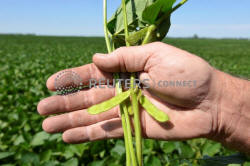Size matters. Big U.S. farms get even bigger amid China trade war
 Send a link to a friend
Send a link to a friend
 [September 17, 2019] By
Mark Weinraub [September 17, 2019] By
Mark Weinraub
HAZELTON, N.D. (Reuters) - As the 2018
harvest approached, North Dakota farmer Mike Appert had a problem - too
many soybeans and nowhere to put them. Selling was a bad option. Prices
were near decade lows as U.S. President Donald Trump's trade war with
China weighed heavily on the market. Temporary storage would only buy
him a little bit of time, particularly in an area where cold weather can
damage crops stored in plastic bags.
So Appert, who farms 48,000 acres (19,425 hectares), cut a check for
$800,000 to build eight new permanent steel bins. Thatallowed him to
hold onto his bumper crop and wait for prices to recover.
He sold half of the 456,000 bushels stored on his farm throughout the
following summer, earning about $1 more per bushel and avoiding storage
at nearby CHS elevators or an Archer Daniels Midland Co. <ADM.N>
processor in the area.
But most farmers do not have $800,000 to spend on steel bins, and many
are going under. The number of U.S. farms fell by 12,800 to 2.029
million in 2018, the smallest ever, as the trade war pushes more farmers
into retirement or bankruptcy.
Roger Hadley, who farms 1,000 acres in Indiana, was unable to plant any
corn and soybeans this year after heavy rains added to farmers' woes.

He spent most of the summer trying to plant a combination of grasses, a
so-called cover crop, so he could apply for government aid and try again
next year.
"The guys that got rich are getting richer," Hadley said. "It has
frustrated a lot of guys."
In farming, size does matter. The farms left standing after the trade
were will likely be some of the biggest in the business. Appert's
operations are more than 100 times bigger than the average American farm
and the advantages provided by that magnitude are becoming even more
critical as the trade war stretches into a second year.
The declining number of U.S. farmers could hurt the world's top grain
merchants such as ADM and Bunge <BG.N>, who will have fewer suppliers.
Additionally, farmers will have less need to rent space in the
merchants' grain silos as big farmers like Appert have plentiful storage
on their own farms.
ADM said it would continue changing to meet the needs of its customers.
Bunge did not respond to an email seeking comment.
By the end of 2018, the average U.S. farm size rose to 443 acres, a
12-year high and up from 441 million in 2017, according to the latest
U.S. Department of Agriculture data.
And the biggest farmers are growing their operations even more as
retiring farmers choose to lease their land rather than selling it.
When land becomes available for lease, only the biggest farmers can
readily shoulder the costs needed to expand.
The size of the loans smaller farmers would need to buy equipment, for
example, are too big for applicants with little collateral, said Dave
Kusler, president of the Bank of Hazelton in Hazelton, North Dakota.
[to top of second column] |

Farmer Doug Zink shows the quality of his soybeans near Carrington,
North Dakota, U.S., August 8, 2019. Picture taken on August 8, 2019.
REUTERS/Dan Koeck

"It is almost impossible with what the costs are," Kuslersaid. "In this area you
can't make a living on 1,000 acres."
Critics say the Trump administration's policy of compensating growers for lost
sales due to the trade war pays the bigger farm operations more, since payments
are calculated by acres farmed.
(For a graphic on Trump's trade war farm bailout: https://graphics.reuters.com/USA-TRADE/0100B0D90TN/USA-TRADE-CHINA:Soybeans.jpg)
The Environmental Working Group, a conservation organization, said in a recent
study the top 1% of aid recipients received an average of more than $180,000
while the bottom 80% were paid less than $5,000 in aid.
Appert said that big farmers receive bigger outright payments but less per acre
than small farms because of a $500,000 cap per farm.
'BOOM, BOOM, BOOM'
Big farms can reap the full benefits of new high-tech equipment that boosts farm
yields.
Doug Zink, who farms 35,000 acres near Carrington, North Dakota, said he likes
to trade in his fleet of four combines and planters nearly every year to ensure
that his equipment is under warranty, which saves thousands of dollars in
maintenance costs and helps avoid breakdowns during key seeding and planting
periods.
They also receive deep discounts - as much as $40,000 for some combine
harvesters that can cost as much as $400,000 - allowing them to upgrade more
often.
Manufacturers are increasingly willing to cut such deals to keep clients as the
number of customers falls. Deere & Co <DE.N> said that it will reduce production
by 20% at its facilities in Illinois and Iowa in the second of half of the year.
Rival agricultural machine makers AGCO Corp <AGCO.N> and CNH Industrial <CNHI.N>
have also slashed production to keep inventory in line with retail demand.
Large farms also have the easiest access to capital, with bankers still eager to
provide loans to growers with plenty of collateral. "The ag trend is going to
larger farms," Kusler, the bank president in Hazelton, North Dakota, said "The
loans get much larger."

Appert had no problem getting a loan to finance expansion.
"If you want to get a mortgage and buy a piece of land it is just boom, boom,
boom," he said.
(Reporting by Mark Weinraub; Editing by Caroline Stauffer and Marguerita Choy)
[© 2019 Thomson Reuters. All rights
reserved.] Copyright 2019 Reuters. All rights reserved. This material may not be published,
broadcast, rewritten or redistributed.
Thompson Reuters is solely responsible for this content. |